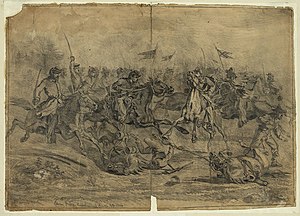| Battle of Brandy Station | |||||||
|---|---|---|---|---|---|---|---|
| Part of the American Civil War | |||||||
 Cavalry Charge Near Brandy Station by Edwin Forbes | |||||||
| |||||||
| Belligerents | |||||||
|
|
| ||||||
| Commanders and leaders | |||||||
| Alfred Pleasonton | J. E. B. Stuart | ||||||
| Units involved | |||||||
| Cavalry Corps, Army of the Potomac | Cavalry Division, Army of Northern Virginia | ||||||
| Strength | |||||||
| 11,000 | 9,500 | ||||||
| Casualties and losses | |||||||
| |||||||
The Battle of Brandy Station, also called the Battle of Fleetwood Hill, was the largest predominantly cavalry engagement of the American Civil War, as well as the largest ever to take place on American soil.[4] It was fought on June 9, 1863, around Brandy Station, Virginia, at the beginning of the Gettysburg Campaign by the Union cavalry under Maj. Gen. Alfred Pleasonton against Maj. Gen. J. E. B. Stuart's Confederate cavalry.
Union commander Pleasonton launched a surprise dawn attack on Stuart's cavalry at Brandy Station. After an all-day fight in which fortunes changed repeatedly, the Federals retired without discovering Gen. Robert E. Lee's infantry camped near Culpeper. This battle marked the end of the Confederate cavalry's dominance in the East. From this point in the war, the Federal cavalry gained strength and confidence.
- ^ "American Battlefield Protection Program (U.S. National Park Service)". www.nps.gov. Archived from the original on 2014-08-13. Retrieved 2020-03-15.
- ^ a b Eicher, p. 493.
- ^ "Battle of Brandy Station Facts & Summary". American Battlefield Trust. January 14, 2009. Archived from the original on February 16, 2020. Retrieved March 15, 2020.
- ^ Brandy Station Foundation (Archived 2007-09-28 at the Wayback Machine). Of the 20,500 men engaged, approximately 3,000 were Union infantrymen. The Battle of Trevilian Station in 1864 was the largest all-cavalry battle of the war. According to the Civil War Trust Archived 2013-05-23 at the Wayback Machine Brandy Station was the largest battle of its kind on American soil.